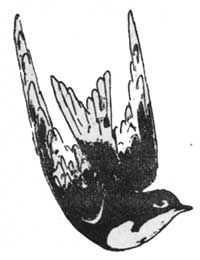

|
By Ranger Naturalist Hugh H. Waesche YAVAPAI OBSERVATION Station on the South Rim of Grand Canyon is an interesting place from which to view the canyon and to learn about its interesting geological history. At the same time the station has a number of features which are intended to appeal purely to a person's sense of beauty. One of the ways in which this is accomplished is by means of large plate glass windows placed at several advantageous points within the walls of the building. There are three of these. One is located in the west wall, another at the east, and a third, a very large one, directly in front of the entrance where one may look out toward the canyon. The largest window gives a very beautiful view of the great masterpiece of erosion, including the North Rim, Bright Angel Creek, Phantom Ranch, the Colorado River at two places, the Tonto Trail, part of Bright Angel Trail and a number of fantastic temples sculptured by the Colorado and its tributaries. Since this large window is situated directly in-front of the main entrance to Yavapai Station, it is the first thing which a visitor sees upon entering the doorway. The exclamations of surprise and admiration by the many people who see it speak for its charm to the public. Because of its clearness and its resemblance to a large painting, the visitors often ask if there is not some unusual feature in the glass itself causing this illusion. Such is not the case. The sides of the window serve as a frame for a restricted view, thus making an indescribably beautiful picture. To the average insect, however, a very different impression is evidently given. That this large plate glass window is a baffling mystery to great numbers of large, brown wasps, Polistes flavus, is apparent. Day after day these busy creatures in their flights to and fro above the canyon rim attempt to make a short cut through the door of the station and through this window. For some reason, inexplainable as far as the wasp is concerned, the short cut does not work and he is abruptly and rudely stopped in his flight. But the wasp seems to have perseverance if nothing else, for he will continue to fly up and down the plate glass seeking some explanation of the unusual phenomenon or more likely some avenue of escape. Just behind him is the door through which he entered and just around the corner several feet away is the open parapet of the station. Why doesn't he fly out through one of these? That is a question! He seems never to do this without some outside assistance. He will flutter up and down the glass for hours and finally drop to the bottom exhausted. New explorers of the wasp world try this supposed short route daily with the same experience. At times there have been as many as a dozen of them at work getting nowhere. 
Although wasps seem to be most easily fooled, other visitors are not uncommon. During the second week in July two birds were victims of this unintentional trap. A red-shafted flicker, Colaptes cafer collaris, was the first. He was temporarily "disqualified" by trying to dash his brains out on this short cut to the canyon. He was taken into the office of the museum for first aid, but soon after, during one of the daily lectures, he left in a hurry. The second bird within two days was one of the white-throated swifts, Aeronautes s. saxatalis, which are often seen over the canyon. They fly at an exceptionally high rate of speed. This particular individual crashed into the pane of glass on the canyon side apparently intending to go through the door and out the opposite side of the building. Because of his tremendous velocity at the time of striking the glass, the swift was fatally injured and died shortly after from a crushed skull. The latest victim of the Yavapai death trap was a small Rufous Hummingbird, Selasphorus rufus. He, like the wasps, flew in the door and then to the window, where he fluttered aimlessly until caught by a young man who was washing the glass at that time. This hummingbird was not harmed other than being temporarily stunned from his first impact with the pane, and after being identified at the naturalist's office, was allowed to escape through the window. | ||||||
| <<< Previous | > Cover < | Next >>> |
vol7-6c.htm
14-Oct-2011